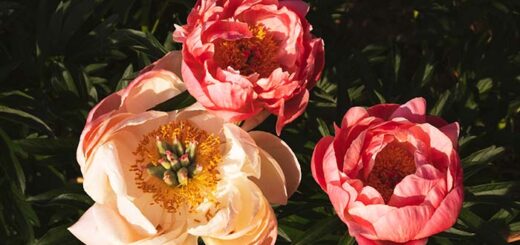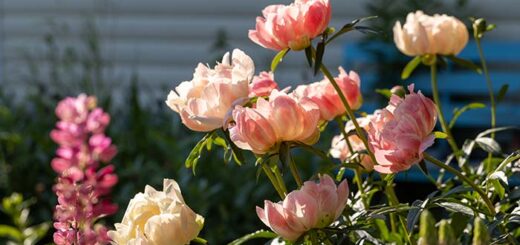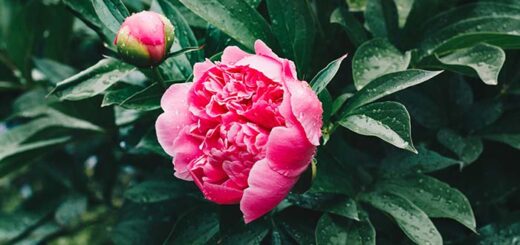Care of Peonies After They Bloom
Peonies are renowned for their breathtakingly beautiful blooms, often becoming the star attraction in any garden. But what happens after these magnificent flowers have shown off their splendor? Proper care for peonies, after they bloom, is crucial to maintaining their health and guaranteeing an equally stunning display the following season. This post-bloom period is critical to providing the attention and care these plants need to thrive year after year.
Once the peony flowers have faded, it’s not just a matter of letting the plant fend for itself until the next bloom cycle. As a dedicated gardener, your role is crucial. You perform deadheading, pruning, fertilizing, and other maintenance tasks to support the plant’s ongoing health and vigor.
Neglecting these steps can lead to a weakened plant, reduced blooming, and potential susceptibility to pests and diseases. Therefore, understanding and implementing the proper care practices during this period can make all the difference in your garden’s beauty and productivity.
But why should you care about these post-bloom steps? Because the health and beauty of your peonies in the next season depend on it. By investing a bit of time and effort now, you can ensure that your peonies continue to be a highlight of your garden, providing lush, vibrant blooms you can enjoy year after year.
Deadheading Spent Blooms
Deadheading is a crucial practice for maintaining the health and appearance of peonies after they have bloomed. This process involves removing the spent flowers from the plant. Deadheading keeps the garden looking tidy and encourages the plant to focus its energy on root and foliage development rather than seed production.
Why Deadhead Peonies?
Deadheading helps prevent the plant from wasting energy on seed formation. Removing the spent blooms allows the plant to channel its resources into strengthening its root system and foliage, which is vital for the plant’s overall health and ability to produce more blooms in the next season. Additionally, deadheading helps prevent the spread of fungal diseases that can thrive on decaying flower petals.

Image Source: Envato Elements
Step-by-Step Guide to Deadheading Peonies
- Tools Needed:
- Pruning shears or scissors: Ensure they are clean and sharp to make precise cuts and prevent the spread of disease.
- Gloves: Protect your hands from sharp foliage and any potential irritants.
- Timing:
- Deadhead peonies as soon as the blooms start to fade and the petals begin to drop. This is usually in late spring or early summer, depending on your local climate and the specific variety of peonies.
- Technique:
- Identify the spent blooms: Look for flowers that have wilted, browned, or started to drop their petals.
- Make the cut: Using your pruning shears, cut the flower stem just above the first set of full, healthy leaves. This ensures you remove the spent bloom while leaving as much foliage as possible to support photosynthesis.
- Please dispose of the spent blooms: Collect the removed flowers and discard them from your garden to prevent any potential spread of disease.
- Tips for Deadheading:
- Be gentle: Handle the plant carefully to avoid damaging the stems and remaining foliage.
- Regular inspection: Check your peonies regularly for new spent blooms and deadhead them promptly to maintain the plant’s health and appearance.
Pruning and Trimming
Pruning and trimming are essential tasks for caring for peonies after they bloom. These practices help maintain the plant’s shape, promote healthy growth, and prevent disease. Proper pruning techniques ensure the plant remains vigorous and ready for the next growing season.
Why Prune Peonies?
Pruning helps remove dead, diseased, or damaged stems and foliage that can harbor pests and diseases. It also helps improve air circulation within the plant, reducing the risk of fungal infections. Additionally, pruning can encourage more robust growth and better blooming in the following season.
Step-by-Step Guide to Pruning Peonies
- Tools Needed:
- Pruning shears or scissors: Ensure they are clean and sharp.
- Gloves: Protect your hands from sharp edges and potential irritants.
- Timing:
- The best time to prune peonies is in the fall after the first frost has caused the foliage to die back. Depending on your climate, this usually occurs in late October to early November.
- Technique:
- Remove dead and diseased stems: Start by cutting away any stems that are brown, black, or show signs of disease. Cut them back to the base of the plant to ensure complete removal.
- Trim spent foliage: Once the foliage has died back after the first frost, cut the stems to about 1-2 inches above the soil level. This helps prepare the plant for dormancy and reduces the risk of disease over the winter.
- Clean up: Collect and dispose of all the pruned material. Do not compost diseased plant material, as this can spread pathogens to other plants.
- Tips for Pruning:
- Sterilize your tools: Clean your pruning shears with rubbing alcohol before and after use to prevent the spread of disease.
- Be thorough: Remove all dead and diseased material to maintain a healthy plant.
Must Read Article: Why Are Your Peonies Not Blooming? Identifying Common Problems
Fertilizing and Soil Care
After blooming, peonies benefit significantly from fertilizing and proper soil care. These practices ensure the plants receive the necessary nutrients to recover from blooming and prepare for the next growing season.
Why Fertilize Peonies?
Fertilizing provides essential nutrients supporting plant growth, root development, and overall health. After the energy-intensive blooming period, peonies need replenished nutrients to build strong roots and foliage for the next season’s blooms.
Recommended Fertilizers for Peonies
Peonies typically benefit from balanced fertilizers or those with a higher phosphorus content to support root development. Here are some common fertilizer types suitable for peonies:
- Balanced fertilizers: Look for formulations like 10-10-10 or 20-20-20.
- Phosphorus-rich fertilizers: Formulations like 5-10-5 or 10-20-10 are ideal for promoting strong root growth.
Step-by-Step Guide to Fertilizing Peonies
- Timing:
- Fertilize peonies twice a year: once in early spring, just as new growth begins, and again in the fall, after the plant has bloomed and before it goes dormant.
- Application Method:
- Spring fertilization: Apply a balanced fertilizer around the base of the plant, avoiding direct contact with the stems. Lightly work the fertilizer into the top inch of soil and water thoroughly.
- Fall fertilization: Use a phosphorus-rich fertilizer to support root development. Apply it around the base of the plant, and work it into the soil and water well.
- Amount to Use:
- Follow the instructions on the fertilizer package for the appropriate amount to use based on the size of your peony plant and the soil conditions in your garden.
- Tips for Fertilizing:
- Avoid over-fertilizing: Excess fertilizer can lead to lush foliage at the expense of blooms and increase the risk of disease.
- Test your soil: Conduct a soil test to determine nutrient levels and adjust your fertilization plan accordingly. This ensures that you are providing the proper nutrients without causing imbalances.
Soil Care for Peonies
In addition to fertilizing, maintaining healthy soil is crucial for the overall health of your peonies. Here are some key practices for soil care:
- Mulching: Apply a layer of organic mulch around the base of the plant to help retain moisture, regulate soil temperature, and suppress weeds. Organic mulches like compost, shredded bark, or leaf mold are ideal.
- Soil pH: Peonies prefer slightly acidic to neutral soil (pH 6.0-7.0). To maintain the optimal range, regularly check the soil pH and amend it if necessary.
- Drainage: Ensure the soil has good drainage to prevent waterlogging, which can lead to root rot. If necessary, improve drainage by incorporating organic matter or creating raised beds.
Watering and Mulching
Proper watering and mulching are essential for the health and longevity of peonies after they have bloomed. These practices help maintain moisture levels, regulate soil temperature, and prevent weed growth, all contributing to a healthier plant.
Importance of Proper Watering Practices
Peonies require consistent moisture, especially after blooming, to support their root development and overall health. However, overwatering can lead to root rot and other diseases, so finding the right balance is crucial.
Recommended Watering Schedule and Techniques
- Watering Frequency:
- Peonies need about 1 inch of water per week from rainfall or supplemental watering. It’s essential to provide additional water during dry periods to meet this requirement.
- Watering Techniques:
- Deep Watering: Water deeply to ensure moisture reaches the root zone. Shallow watering can weaken roots.
- Avoid Overhead Watering: Use a soaker hose or drip irrigation system to water the base of the plant, avoiding the foliage. Overhead watering can promote fungal diseases.
- Morning Watering: Water in the morning to allow the foliage to dry out during the day, reducing the risk of fungal infections.
- Signs of Underwatering and Overwatering:
- Underwatering: Wilting, dry soil, and stunted growth.
- Overwatering: Yellowing leaves, soggy soil, and root rot.
Benefits of Mulching for Peonies
Mulching provides several benefits, including moisture retention, temperature regulation, and weed suppression. It also adds organic matter to the soil as it decomposes, improving soil structure and fertility.
Step-by-Step Guide to Mulching Peony Plants
- Timing:
- Apply mulch in the spring after the soil has warmed up and in the fall after the first frost to provide winter protection.
- Materials Needed:
- Organic mulches such as compost, shredded bark, straw, or leaf mold are ideal.
- Application Method:
- Layer Thickness: Apply a 2-3 inch layer of mulch around the base of the plant, extending out to the drip line.
- Avoid Stem Contact: Keep the mulch a few inches from the stems to prevent rot.
- Replenish as Needed: Replenish the mulch layer annually to maintain its benefits.
- Tips for Mulching:
- Use organic mulch to improve soil health over time.
- Monitor the mulch layer to ensure it remains effective and replace it if it becomes compacted or decomposed.
Pest and Disease Management
Pests and diseases can pose significant threats to peonies, particularly after they have bloomed and the plants focus on storing energy for the next growing season. Effective management practices are essential to keep your peonies healthy and thriving.
Common Pests and Diseases Affecting Peonies
- Pests:
- Aphids: Small, sap-sucking insects that can weaken plants.
- Thrips: Tiny insects that feed on flowers and foliage.
- Ants: Often found on peony buds, attracted by the nectar. While they are not harmful, they can be a nuisance.
- Diseases:
- Botrytis Blight: A fungal disease causing brown spots and moldy growth on stems and leaves.
- Powdery Mildew: White, powdery fungal growth on leaves.
- Leaf Spot: Fungal or bacterial spots on leaves, leading to defoliation.
Prevention and Treatment Methods
- Identifying Signs of Pest Infestations or Diseases:
- Regularly inspect your plants for signs of pests and diseases, such as discolored leaves, spots, mold, or visible insects.
- Organic and Chemical Treatment Options:
- Aphids and Thrips: Use insecticidal soap or neem oil. Introduce beneficial insects like ladybugs.
- Botrytis Blight and Powdery Mildew: Apply fungicides and ensure proper air circulation by spacing plants appropriately.
- Leaf Spot: Remove and destroy affected leaves. Apply appropriate fungicides if necessary.
- General Tips for Pest and Disease Management:
- Clean Garden Practices: Remove and dispose of diseased plant material promptly.
- Proper Spacing: Ensure good air circulation around your plants to reduce humidity and prevent fungal growth.
- Healthy Plants: Maintain plant health through proper watering, fertilization, and pruning to make them more resistant to pests and diseases.
Preparing for Winter
Properly preparing peonies for winter is crucial to ensure they survive the cold months and emerge healthy and ready to grow in the spring.
Importance of Preparing Peonies for Winter
Winter preparation helps protect peony roots from freezing temperatures and reduces the risk of damage from winter weather. It also helps prevent diseases that can thrive in fallen foliage left on the ground.
Step-by-Step Guide to Winterizing Peony Plants
- Timing:
- Start preparing your peonies for winter after the first frost when the foliage has died.
- Techniques:
- Cutting Back Foliage: After the first frost, cut the stems down to about 1-2 inches above the soil level. This helps prevent diseases from overwintering in the plant material.
- Adding Mulch: Apply a 2-3 inch layer of mulch over the root zone to insulate the soil and protect the roots from freezing temperatures. Use materials like straw, pine needles, or shredded bark.
- Cleaning Up: Remove all fallen leaves and plant debris around the peonies to reduce disease risk.
- Tips for Protecting Peonies from Harsh Winter Conditions:
- Avoid Over-Mulching: While mulch is beneficial, avoid piling it directly against the stems, which can cause rot.
- Check Mulch Layer: Periodically check the mulch layer during the winter to ensure it remains in place and provides adequate protection.
Final Thoughts
Taking care of peonies after they bloom is essential for maintaining the health and beauty of these beloved garden plants. Proper post-bloom care ensures that peonies will thrive and produce stunning flowers yearly. By following the detailed steps of deadheading, pruning, fertilizing, watering, mulching, pest and disease management, and preparing for winter, gardeners can create an optimal environment for their peonies to flourish.
Peonies require attention and effort, but the rewards are well worth it. A well-cared-for peony plant will enhance the aesthetic appeal of your garden and provide a sense of accomplishment and joy each blooming season. Remember that the key to successful peony care is consistency and attentiveness to the plant’s needs throughout the year.
Whether you are a seasoned gardener or a novice, implementing these best practices will help you achieve a garden filled with healthy, vibrant peonies. Invest in your peonies’ post-bloom care, and you will be rewarded with a spectacular floral display that will envy your neighborhood.
FAQ on Care of Peonies After They Bloom
Q: When should I start deadheading my peonies?
A: You should start deadheading your peonies as soon as the blooms fade and the petals drop, usually in late spring to early summer.
Q: How far back should I cut when deadheading peonies?
A: Cut the flower stem just above the first set of full, healthy leaves to ensure the plant retains as much foliage as possible for photosynthesis.
Q: What type of fertilizer is best for peonies after they bloom?
A: A balanced fertilizer, such as 10-10-10, is suitable for overall health, while a phosphorus-rich fertilizer, like 10-20-10, is ideal for promoting robust root development.
Q: How often should I water my peonies after they have bloomed?
A: Peonies need about 1 inch of water per week. You may need to water more frequently during dry periods to maintain consistent moisture.
Q: What are common pests that affect peonies after blooming?
A: Common pests include aphids, thrips, and ants. While ants are not harmful to peonies, aphids, and thrips can cause damage and should be controlled.
Q: How do I prevent fungal diseases in my peonies?
A: To prevent fungal diseases, ensure proper air circulation by spacing plants appropriately, avoid overhead watering, and promptly remove and dispose of any diseased plant material.
Q: When is the best time to prune peonies?
A: The best time to prune peonies is in the fall, after the first frost when the foliage has died.
Q: How should I mulch my peonies for winter protection?
A: Apply a 2-3 inch layer of organic mulch, such as straw or shredded bark, around the base of the plant, keeping it a few inches away from the stems to prevent rot.
Q: Can I use compost as mulch for my peonies?
A: Yes, compost is an excellent mulch for peonies. As it decomposes, it helps retain moisture, suppress weeds, and add nutrients to the soil.
Q: What should I do if my peonies show signs of disease after blooming?
A: If your peonies show signs of disease, promptly remove and dispose of the affected plant material. Apply appropriate fungicides if necessary and improve cultural practices like spacing and watering techniques to prevent further issues.
References:
American Peony Society
- “Peony Care Basics”
- Available at: American Peony Society – Peony Care
- This comprehensive guide from the American Peony Society covers various aspects of peony care, including planting, watering, fertilizing, and pest management.
Royal Horticultural Society
- “Peony (Paeonia) Care”
- Available at: Royal Horticultural Society – Peonies
- The RHS provides detailed information on growing and caring for peonies, including specific advice on pruning, feeding, and common problems.
University of Illinois Extension
- “Peonies: Planting and Care”
- Available at: University of Illinois Extension – Peonies
- This resource from the University of Illinois Extension offers practical tips on planting, seasonal care, and managing diseases and pests in peonies.


